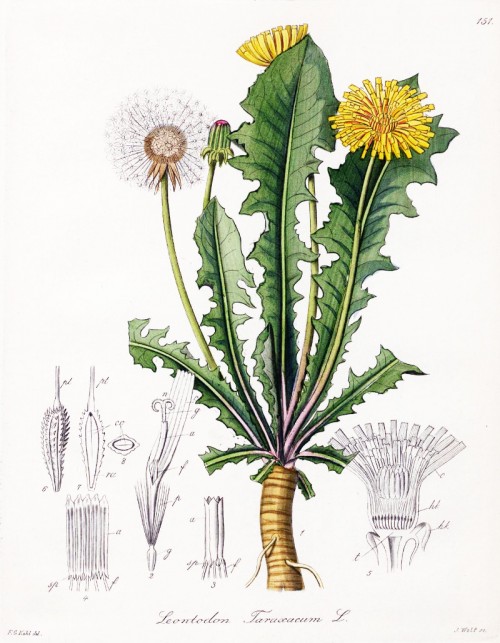Taraxacum officinale Wigg. - syn.Taraxacum vulgare Schrank; Leontodon taraxacum L. - Asteraceae
(common) dandelion, lion's-tooth, (Gewöhnlicher, Gemeiner) Löwenzahn, Gemeine Kuhblume, Pusteblume
Perennial herb, up to 40cm high, native to Europe, Asia, naturalized in North America; taproot up to 30cm long; whole plant and especially the stalks with white milky sap; leaves 5-25cm long, lanceolate, deeply lobed, forming a basal rosette; flowers shiny golden-yellow, solitary at the top of hollow stalks; fruits forming a rounded, white-haired seed-head known as dandelion clock.
Tender young leaves are considerably less bitter than older leaves so they are used in salads. Many dialectal names refer to its roots diuretic effect: bed-wetter, bed-piddler.
http://de.wikipedia.org/wiki/Gew%C3%B6hnlicher_L%C3%B6wenzahn
„The roasted dandelion root pieces and the beverage have some resemblance to coffee in appearance and taste.“
http://en.wikipedia.org/wiki/Dandelion_coffee
„The investigation of the roots and the aerial parts of Taraxacum officinale afforded, in addition to known compounds, a new eudesmanolide, a tetrahydroridentin B, a eudesmanolide-β-d-glucopyranoside and two germacranolide acids, which are esterified with β-d-glucose. The latter two seem to represent a new type of sesquiterpene lactone. All three of the new glucose derivatives have a strong bitter taste.“
[Sesquiterpenlacton-β-D-glucopyranoside sowie ein neues Eudesmanolid aus Taraxacum officinale., Hänsel, R., Kartarahardja, M., Huang, J.T., Bohlmann, F., Phytochemistry, Vol.19(5), 1980, 857-861]
The sesquiterpene lactone derivative taraxinic acid 1'-O-beta-D-glucopyranoside is a contact sensitizer of dandelion.
[Taraxinic acid 1'-O-beta-D-glucopyranoside, the contact sensitizer of dandelion (Taraxacum officinale Wiggers)(author's transl)., Hausen, B.M., Dermatosen in Beruf und Umwelt. Occupation and environment, Vol.30(2), 1982, 51]
„Five germacrane- and guaiane-type sesquiterpene lactones, including two previously described taraxinic acid derivatives, were isolated from the roots of Taraxacum officinale, together with benzyl glucoside, dihydroconiferin, syringin and dihydrosyringin. The other three lactones were identified as 11β,13-dihydrolactucin, ixerin D and ainslioside.“
[Further sesquiterpenoids and phenolics from Taraxacum officinale., Kisiel, W., Barszcz, B., Fitoterapia, Vol.71(3), 2000, 269-273]
„Chemical examination of the MeOH extract of the root of Taraxacum officinale, which exhibited inhibitory activity on the formation of leukotriene B4 from activated human neutrophils, has resulted in the isolation of 14-O-β-D-glucosyl-11,13-dihydro-taraxinic acid (1) and 14-O-β-D-glucosyl-taraxinic acid.“
[Sesquiterpene glucosides from anti-leukotriene B4 release fraction of Taraxacum officinale., Kashiwada, Y., Takanaka, K., Tsukada, H., Miwa, Y., Taga, T., Tanaka, S., Ikeshiro, Y., Journal of Asian natural products research, Vol.3(3), 2001, 191-197]
Supercritical fluid (CO2) extracts of the leaves (3.2-4.0% dry weight of raw material) contained the triterpenes β-amyrin (11.0-12.7%) and β-sitosterol (3.1-3.7%).
[Supercritical fluid extraction of dandelion leaves., Simandi, B., Kristo, S.T., Kery, A., Selmeczi, L.K., Kmecz, I., Kemény, S., The Journal of supercritical fluids, Vol.23(2), 2002, 135-142]
http://quimica.udea.edu.co/~carlopez/cromatosfc/dienteleon_sfe_2002.pdf
The fresh or dried leaves, roots, or both (Taraxacum radix cum herba) are used as diuretic and bitter tonic. „The young leaves are eaten as a salad (traditionally a 'spring salad' in Europe), while roots collected in autumn (when rich in inulin) are dried and roasted as a coffee substitute…
Dandelion is mainly used as a diuretic but is also an appetite-stimulating bitter tonic, thought to be useful to treat stomach, liver, gall bladder and rheumatic complaints. It is applied externally for eczema and other skin conditions. Because of the high inulin content dandelion tea can be useful for patients with diabetes… Repeated exposure to the milky latex may cause contact dermatitis.“
[Medicinal Plants of the World. Ben-Erik Van Wyk and Michael Wink, Pretoria 2004, 318]
„To investigate the efficacy and the mechanism of the anti-inflammatory effect of Taraxacum officinale leaves (TOLs), the effect of a methanol extract and its fractions recovered from TOLs on lipopolysaccharide (LPS)-induced responses was studied in the mouse macrophage cell line, RAW 264.7… Among the fractions of the methanol extract, the chloroform and ethyl acetate fractions exhibited the most effective anti-inflammatory activities. These results show that the anti-inflammatory effects of TOLs are probably due to down-regulation of NO, PGE2, and pro-inflammatory cytokines and reduced expressions of iNOS and COX-2 via inactivation of the MAP kinase signal pathway.“
[Anti-inflammatory effect of Taraxacum officinale leaves on lipopolysaccharide-induced inflammatory responses in RAW 264.7 cells., Koh, Y.J., Cha, D.S., Ko, J.S., Park, H.J., Choi, H.D., Journal of medicinal food, Vol.13(4), 2010, 870-878]
„Taraxasterol, a pentacyclic-triterpene, was isolated from the Chinese medicinal herb Taraxacum officinale… taraxasterol inhibited NO, PGE2, TNF-α, IL-1β and IL-6 production in LPS-induced RAW 264.7 macrophages in a dose-dependent manner. Further studies revealed that taraxasterol prevented the LPS-induced NF-κB translocation from cytoplasm into nuclear… These results indicate that taraxasterol has anti-inflammatory effect by blocking NF-κB pathway.“
[Effects of taraxasterol on inflammatory responses in lipopolysaccharide-induced RAW 264.7 macrophages., Zhang, X., Xiong, H., Liu, L., Journal of Ethnopharmacology, Vol.141(1), 2012, 206-211]
T.officinale leaves are very nutritious with high content of protein, potassium, calcium and iron.
[Total Lipids, Proteins, Minerals and Essential Oils of Taraxacum Officinale L. Growing Wild in Kosovo., Faiku, F., International Journal of Pharmaceutical and Phytopharmacological Research, Vol.3(3), 2014, 254-257]
http://pharmamedix.in/journals/index.php/IJPPR/article/download/112/pdf_33
Contents (100g aerial parts): Protein 2.7g, potassium 397mg, calcium 187mg, iron 3.1mg. [USDA DB entry 11207, Dandelion greens, raw]
http://ndb.nal.usda.gov/ndb/foods/show/2996?fgcd=&manu=&lfacet=&format=Full&count=&max=35&offset=&sort=&qlookup=11207

Taraxacum officinale Webb [as Leontodon taraxacum L.]
Kohl, F.G., Die officinellen Pflanzen der Pharmacopoea Germanica, t.151 (1891-1895) [F.G. Kohl]
http://plantgenera.org/species.php?id_species=999560
